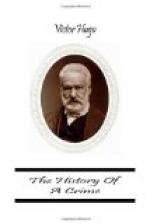At the moment when this strange butchery began, the seat of the Committee was still in the Rue Richelieu. I had gone back to it after the exploration which I had thought it proper to make at several of the quarters in insurrection, and I gave an account of what I had seen to my colleagues. Madier de Montjau, who also arrived from the barricades, added to my report details of what he had seen. For some time we heard terrible explosions, which appeared to be close by, and which mingled themselves with our conversation. Suddenly Versigny came in. He told us that horrible events were taking place on the Boulevards; that the meaning of the conflict could not yet be ascertained, but that they were cannonading, and firing volleys of musket-balls, and that the corpses bestrewed the pavement; that, according to all appearances, it was a massacre,—a sort of Saint Bartholomew improvised by the coup d’etat; that they were ransacking the houses at a few steps from us, and that they were killing every one. The murderers were going from door to door, and were drawing near. He urged us to leave Grevy’s house without delay. It was manifest that the Insurrectionary Committee would be a “find” for the bayonets. We decided to leave, whereupon M. Dupont White, a man distinguished for his noble character and his talent, offered us a refuge at his house, 11, Rue Monthabor. We went out by the back-door of Grevy’s house, which led into 1, Rue Fontaine Moliere, but leisurely, and two by two, Madier de Montjau with Versigny, Michel de Bourges with Carnot, myself arm-in-arm with Jules Favre. Jules Favre, dauntless and smiling as ever, wrapped a comforter over his mouth, and said, “I do not much mind being shot, but I do mind catching cold.”
Jules Favre and I reached the rear of Saint Roch, by the Rue des Moulins. The Rue Veuve Saint Roch was thronged with a mass of affrighted passers-by, who came from the Boulevards flying rather than walking. The men were talking in a loud voice, the women screaming. We could hear the cannon and the ear-piercing rattle of the musketry. All the shops were being shut. M. de Falloux, arm-in-arm with M. Albert de Resseguier, was striding down the Rue de Saint Roch and hurrying to the Rue Saint Honore. The Rue Saint Honore presented a scene of clamorous agitation. People were coming and going, stopping, questioning one another, running. The shopkeepers, at the threshold of their half-opened doors, asked the passers-by what was taking place, and were only answered by this cry, “Oh, my God!” People came out of their houses bareheaded and mingled with the crowd. A fine rain was falling. Not a carriage in the street. At the corner of the Rue Saint Roch and Rue Saint Honore we heard voices behind us saying, “Victor Hugo is killed.”
“Not yet,” said Jules Favre, continuing to smile, and pressing my arm.
They had said the same thing on the preceding day to Esquiros and to Madier de Montjau. And this rumor, so agreeable to the Reactionaries, had even reached my two sons, prisoners in the Conciergerie.




